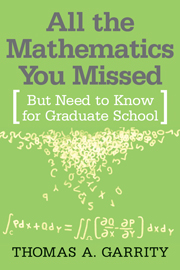Book contents
- Frontmatter
- Contents
- Preface
- On the Structure of Mathematics
- Brief Summaries of Topics
- 1 Linear Algebra
- 2 ∈ and δ Real Analysis
- 3 Calculus for Vector-Valued Functions
- 4 Point Set Topology
- 5 Classical Stokes' Theorems
- 6 Differential Forms and Stokes' Thm.
- 7 Curvature for Curves and Surfaces
- 8 Geometry
- 9 Complex Analysis
- 10 Countability and the Axiom of Choice
- 11 Algebra
- 12 Lebesgue Integration
- 13 Fourier Analysis
- 14 Differential Equations
- 15 Combinatorics and Probability
- 16 Algorithms
- A Equivalence Relations
- Bibliography
- Index
5 - Classical Stokes' Theorems
Published online by Cambridge University Press: 11 April 2011
- Frontmatter
- Contents
- Preface
- On the Structure of Mathematics
- Brief Summaries of Topics
- 1 Linear Algebra
- 2 ∈ and δ Real Analysis
- 3 Calculus for Vector-Valued Functions
- 4 Point Set Topology
- 5 Classical Stokes' Theorems
- 6 Differential Forms and Stokes' Thm.
- 7 Curvature for Curves and Surfaces
- 8 Geometry
- 9 Complex Analysis
- 10 Countability and the Axiom of Choice
- 11 Algebra
- 12 Lebesgue Integration
- 13 Fourier Analysis
- 14 Differential Equations
- 15 Combinatorics and Probability
- 16 Algorithms
- A Equivalence Relations
- Bibliography
- Index
Summary
Basic Objects: Manifolds and boundaries
Basic Maps: Vector-valued functions on manifolds
Basic Goal: Function's average over a boundary = Derivative's average over interior
Stokes' Theorem, in all of its many manifestations, comes down to equating the average of a function on the boundary of some geometric object with the average of its derivative (in a suitable sense) on the interior of the object. Of course, a correct statement about averages must be put into the language of integrals. This theorem provides a deep link between topology (the part about boundaries) and analysis (integrals and derivatives). It is also critical for much of physics, as can be seen in both its historical development and in the fact that for most people their first introduction to Stokes' Theorem is in a course on electricity and magnetism.
The goal of Chapter Six is to prove Stokes' Theorem for abstract manifolds (which are, in some sense, the abstract method for dealing with geometric objects). As will be seen, to even state this theorem takes serious work in building up the necessary machinery. This chapter looks at some special cases of Stokes' Theorem, special cases that were known long before people realized that there is this one general underlying theorem. For example, we will see that the Fundamental Theorem of Calculus is a special case of Stokes' Theorem (though to prove Stokes' Theorem, you use the Fundamental Theorem of Calculus; thus logically Stokes' Theorem does not imply the Fundamental Theorem of Calculus).
- Type
- Chapter
- Information
- All the Mathematics You MissedBut Need to Know for Graduate School, pp. 81 - 110Publisher: Cambridge University PressPrint publication year: 2001



